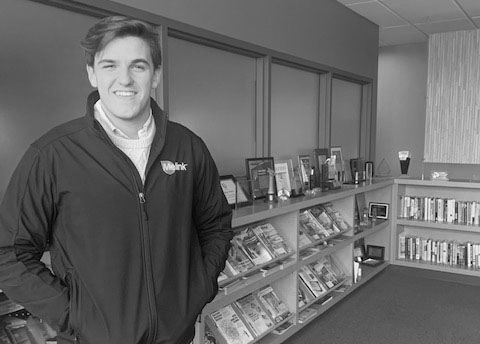Engineers serve a variety of roles at Melink Corporation — application, project, tech support, product design, and field service. In honor of National Engineer Week (Feb 16-22, 2020), Melink employee-owners are sharing what they do. Read along in a day in the life of…

Tom Critchfield
Quality Engineer & Field Service Engineer
I am currently in a dual role at Melink. As a Quality Engineer, I typically wake up early and log on to our internal server to see the Test & Balance queue status. I’ll catch up on emails and have a check-in phone call with the Field Service Manager to see if there is anything urgent from the customer service team or field technicians. The rest of my day consists of reviewing submitted reports, providing feedback to technicians, and planning potential quality assurance audits for the following days or weeks. Depending on the day, I will also be involved in meetings and technician education programs.
Then, as a Field Service Engineer, a large chunk of my time is spent traveling and getting to the various T&B job sites. This includes driving, flying, and speaking with border agents to gain access to Canada. Once on site, I speak with the site superintendent, mechanical contractor, electrical contractor, and anyone else I’ll need to be working with to complete the job. This is followed by data collection and report construction. The rest of the time is just balance completion and finishing the report.

Josh Gerlock
Business Development Manager
With my engineering degree, I have become a technical sales consultant for Melink. I often start my day studying industry news and learning about the latest technology trends that my customers are following. From there, I check for any emails that came in the night before while I was not at work and take care of any pressing replies. Next, I move on to new projects by finalizing proposals and creating an energy analysis. The energy analysis is used to show our potential customers how much energy and money our Intelli-Hood® system can save them. On any given day I could be presenting the analysis to customers through a webinar or over the phone to help make sure they understand everything. Part of the day involves being reactive as well by fielding calls and answering customers’ questions. With products that are very technical, there are plenty of times I do not have all the answers, but I always know where to go to make sure I find them or connect my customers with someone who does. Almost three years in, I am still learning new things, so I am always on my toes!

Anna Rusconi
Account Engineer
The Account Engineer role at Melink varies from day to day from working with the customer to working with the technicians to collecting data analytics. When we receive a Test & Balance quote request from one of our national accounts, I look through the mechanical prints to prepare a quote. The quote covers the scope of work for the visit, as well as the estimated time needed for an on-site technician. Before our technicians visit on site, I make sure they are equipped with all the information they need to successfully complete the job. If the technician has any questions while on site, I work with them and our site contacts to ensure the visit goes as smooth as possible. Once the T&B is completed and the final report is sent to the customer, I will work with the customer to help them understand the information.
Also, when we visit customers or have customers visit our office, we provide them with an overview of their project data from the previous years. I work with the National Account Manager to pull data to present to the customers. I really enjoy this position because each day is different, and it is rewarding to help the customers and the internal team.

Darren Witter
Vice President of Human Resources
Earlier in my career, I applied my engineering education to more “traditional” engineering vocations. These included product development, manufacturing, design, commissioning, and green building construction and operation. These experiences were incredibly valuable, and I enjoyed them immensely. Now, after more than two decades into my profession, I apply my engineering principles and training in other ways. Though different from what I first envisioned as an engineering student, these ways are equally exciting, challenging, and fun! I help fellow Melink employee-owners with career development by providing training on technical concepts, soft skills, company values, and lessons from my personal experience. I meet students and prospective employees and explain our unique company mission and culture, our products and services, and career opportunities. I provide tours to visitors of Melink’s Zero-Energy headquarters, one of the greenest buildings on the planet, and inspire them to be more sustainable in their lives. I seek ways to improve processes and strengthen our businesses. And, most importantly, I help to care for our greatest asset at Melink… our employees. Years of solving technical problems as an engineer have helped prepare me to now solve business challenges, to guide and mentor others, and to make the world a better place!

Sarah Evans
Embedded Software Engineer
As an engineer at Melink, my job is to take the ideas for what we want PositiV® or Intelli-Hood® to do and implement them. Since I started working at Melink, my main focus has been on PositiV, our building health monitor system. My work includes programming the PositiV devices, maintaining an application for setting up the devices, collecting and analyzing data, and testing. While all these tasks involve software development, each problem is unique and can require a number of different solutions. Essentially, my day-to-day includes solving puzzles, which I really enjoy.
Want to be a Melink engineer? Check out our Careers page.
